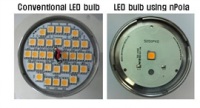Seoul Semiconductor claims 5x brightness with non-polar LEDs 10 Jul 2012 Seoul Semiconductor has announced that it will introduce LEDs based on non-polar technology,which it claims will deliver over 5x the lumens per unit area of conventional LEDs.Seoul Semiconductor,an LED manufacturer based in Seoul,Korea,has unveiled a new LED product based on non-polar gallium nitride(GaN)technology,which it has stated will deliver 5x the brightness per unit area of die than conventional LEDs.At the same time,the University of California(UC)in Santa Barbara has received a$500,000 endowment from Seoul Optodevice Company and James Speck has been named the campus's first Seoul Optodevice Chair in Solid State Lighting.
Non-polar GaN

Conventional vs.nPola Non-polar technology involves the utilization of the one of the non-polar planes in the GaN crystal,either the a-plane or m-plane,whereas traditional LEDs currently utilize the polar c-plane.Non-polar LEDs offer the potential of reduced electrical resistance,increased electrical efficiency,reduction in color shifting with varying operating current,and smaller device size.
Seoul Semiconductor's patented nPola approach has been under development for over 10 years.According to the company,the brightness of its LEDs has been dramatically improved by 5x over the conventional LED based on equivalent die surface area and it expects to further improve this margin to 10x with future implementations.
Currently,the brightness of a power chip LED in mass production is approximately 100 lm(warm white)but this new product could produce 500 lm using the same supplied power.Fewer LEDs are needed per replacement bulb.For example,in a 60W-equivalent LED lamp,generally 10-20 LED packages are used,but when the nPola product,the same brightness could be achieved using 1-2 packages.
Seoul Semiconductor CEO,Chung Hoon Lee,expressed strong confidence in the new product by saying"I've worked very hard for the past 20 years in this industry and it is safe to say that this new product is the culmination of 20 years of core technologies development.It is a major milestone for the LED light source."
UC Santa Barbara receives$500,000 for Endowed Chair
UC Santa Barbara's Solid State Lighting&Energy Center(SSLEC),a provider of leading-edge research in energy-efficient lighting,power electronics,and solar energy technology,has received a$500,000 endowment from Seoul Optodevice Company to further its research on GaN for use in electronics and solid-state lighting(SSL).
James Speck,a professor of materials at UCSB,member of SSLEC's Executive Committee,and director of the Interdisciplinary Center for Wide Band-Gap Semiconductors,has been named the campus's first Seoul Optodevice Chair in Solid State Lighting.

Jim Speck"Mr.Chung Hoon Lee and the Seoul Optodevice Company are leaders in the field,and have been longstanding supporters of UC Santa Barbara's Solid State Lighting and Energy Center,which is advancing the frontiers of research in energy-efficient solid-state lighting,and helping to create a more sustainable future for us all,"said Chancellor Henry Yang."We are deeply grateful for their vision and generosity in establishing the Seoul Optodevice Chair in Solid State Lighting,and we are very proud that Professor Jim Speck will be the inaugural chair holder."
"This endowment by Seoul Optodevice Company is critically important because our research in gallium nitride semiconductors places the college at the forefront of energy efficiency technology,"said Rod Alferness,dean of the College of Engineering."Professor Speck is leading this charge and understands how our relationship with industry is a driving force behind discoveries in solid state lighting."
Speck's research focuses on the relationship between thin-film electronic materials growth,and microstructure,as well as the link between microstructure and physical properties.In 2010,he received the IEEE Photonics Society Aron Kressel Award for his work on nonpolar and semipolar GaN-based materials and devices.



